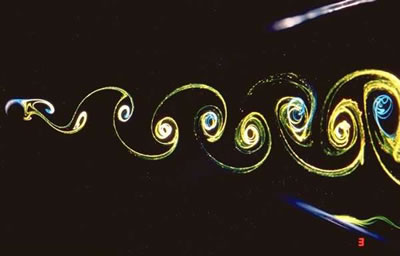|
Full Orchestra
String Orchestra
Wind Ensemble
Vocal
Chamber
Solo Instrumental
Clarinet Compositions
Saxophone Compositions
|
 Far From Equilibrium is structured in four sections, each concentrating on different aspects of the physics of turbulence. The first section begins with the ensemble breathing together with the dancers. Envisioning a pot of water beginning to heat up, at the start, all parts are synchronized. A progression of four harmonies emerges from the breathing, and as the water heats up and convection currents form, the ensemble begins to split apart into a four-part canon that gradually spreads apart over time. Energy is continually added to the system until it reaches its breaking point and the water boils; the expanding canon breaks sharply into turbulent chaos.
Far From Equilibrium is structured in four sections, each concentrating on different aspects of the physics of turbulence. The first section begins with the ensemble breathing together with the dancers. Envisioning a pot of water beginning to heat up, at the start, all parts are synchronized. A progression of four harmonies emerges from the breathing, and as the water heats up and convection currents form, the ensemble begins to split apart into a four-part canon that gradually spreads apart over time. Energy is continually added to the system until it reaches its breaking point and the water boils; the expanding canon breaks sharply into turbulent chaos.
The second section presents a series of episodes that all begin at the same point. A constant flow of notes represents the flow of a fluid, growing into a more active texture full of rhythmic interjections and instabilities. Three times, this flow is reset, and each time, there is an increase in the Reynolds Number of the fluid - that is, the value that describes its propensity to become turbulent. Each repetition results in a quicker escalation to turbulence and more extreme energy once that state is reached. At the apex of the final iteration, the swirling clarinet lines coalesce into a rhythmic unison before finally breaking apart and transitioning to the third section without pause.
While turbulence is chaotic and often seems very random, there is a predictable progression of shapes that one can observe on various levels of size within a fluid. The third section focuses on various shapes of turbulence and the typical flow of energy from one shape to another. The playful melody that immediately bounces around the ensemble represents blobs that form when a volume of a fluid begins to rotate together and act as a single unit. Blobs naturally flatten and become sheets, represented by a repeated note figure in mixed meters that is always played in rhythmic unison with at least two members of the ensemble. These sheets then begin to rotate into tube structures, represented by a forceful melody that starts with a punctuated octave leap and then settles into an undulating gesture. First stated by one instrument alone, then with two in canon, this section culminates in a three-part strict canon of this motive that is eventually joined by an augmentation of itself in the fourth part. Once again, the organized structure of the music breaks down and transitions into the final section.
The fourth section brings together elements of each of the previous sections. Beginning with an aleatoric re-sequencing of the three shapes from the third movement, each instrument proceeds at a different speed to increase the chaotic nature of the music. A completely improvised section follows, with the musicians winding their energy down from turbulence to near stasis, but an aggressive rhythm compels the ensemble to begin a three-part canon reminiscent of the fluid from the second section. Once this canon naturally breaks down and dissolves away, a return to the violent turbulence from the first section jolts the music into motion one last time.
Far From Equilibrium was written in collaboration with Elizabeth Hicks, physicist, and Megan Rhyme, choreographer. The performance may be with dancers or without.
Duration: ca. 24'
|

 Far From Equilibrium is structured in four sections, each concentrating on different aspects of the physics of turbulence. The first section begins with the ensemble breathing together with the dancers. Envisioning a pot of water beginning to heat up, at the start, all parts are synchronized. A progression of four harmonies emerges from the breathing, and as the water heats up and convection currents form, the ensemble begins to split apart into a four-part canon that gradually spreads apart over time. Energy is continually added to the system until it reaches its breaking point and the water boils; the expanding canon breaks sharply into turbulent chaos.
Far From Equilibrium is structured in four sections, each concentrating on different aspects of the physics of turbulence. The first section begins with the ensemble breathing together with the dancers. Envisioning a pot of water beginning to heat up, at the start, all parts are synchronized. A progression of four harmonies emerges from the breathing, and as the water heats up and convection currents form, the ensemble begins to split apart into a four-part canon that gradually spreads apart over time. Energy is continually added to the system until it reaches its breaking point and the water boils; the expanding canon breaks sharply into turbulent chaos.